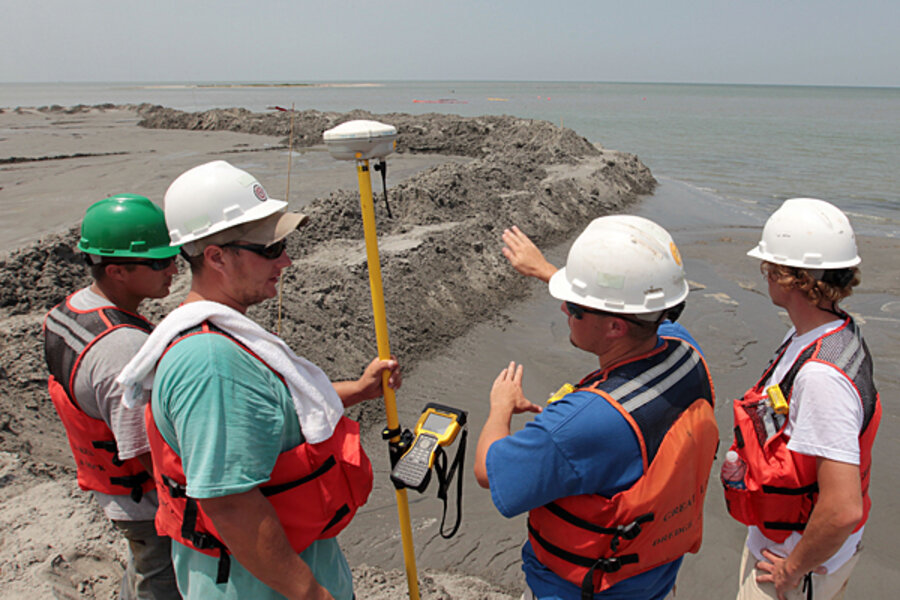Scientists team up to attack Louisiana's Gulf oil spill berm plan
Loading...
A group of prominent coastal scientists is calling for a halt to large-scale engineering projects – like Louisiana's berm plan – aimed at protecting wetlands from encroaching oil from the Gulf oil spill. They want experts to have time to review the longer-term effects these projects could have on the natural processes that sculpt and sustain the coastline.
The danger, they argue, is that the projects will siphon cash from more cost-effective approaches to dealing with the oil, such as expanded use of skimmers and booms. Moreover, the projects could well waste the relatively small amounts of offshore sand that was to be used to build up the Mississippi Delta and slow its long-term erosion.
The call came in an open letter to retired Coast Guard Adm. Thad Allen, who heads the oil spill response effort. The letter was released July 21 and signed by 21 researchers from coastal-studies institutes in the Gulf region as well as around the country.
IN PICTURES: The Gulf oil spill's impact on nature
The Louisiana berm project involves building 40 miles of sand berms to augment what remains of once robust barrier islands. The letter also targets projects that have emerged in other Gulf states and which reportedly have not received approval from any state or federal regulators.
'Armored' berms?
State and local officials in Louisiana have begun talking about "armoring" berms the state builds. Workers would add large boulders or plant grasses to stabilize the berms and reduce the pace of erosion the berms would face.
"That's a completely different ball game," says Robert Young, a researcher who heads the Program for the Study of Developed Coastlines at Western Carolina University and a driving force behind the call for a pause in spill-related coastal engineering projects.
Armoring would convert the berms from a short-term tool for blocking oil to a longer-term change in the coastal landscape. Such changes could alter currents, alter the quality of seawater behind the berms, and movement of sediment along the coast in ways that could affect the health of the coastline at locations beyond the site of the berm itself.
The group says no additional long, expensive studies are needed; a large body of results already exists to better inform decisions on whether to pursue such projects.
But to this point, projects that have garnered formal approval have received it on an emergency basis, without the careful analysis the state or federal laws would otherwise require.
Louisiana: It's working
The biggest projects so far belong to the state of Louisiana. For their part, state officials say that the berm plan – even in its partially completed state – has been successful.
Last week, in surveying a berm-building project along the northern stretch of the Chandeleur Islands, Louisiana Gov. Bobby Jindal noted that during one day the previous week, 500 pounds of oil-soaked debris had been collected from the berm.
The state is seeking permission to build an additional 61 miles of berms along the coast.
Yet coastal scientists say that experience also has shown that Louisiana's berm project is likely to be an exercise in futility.
Some of the berm work along the Chandeleurs vanished after a pounding from surf kicked up by hurricane Alex. Now, tropical storm Bonnie’s current track puts it on a collision course with the Louisiana coast and the fledgling berms.
The berm project is moving so slowly "that it will never 'close the door' to the oil," the researchers argue in the letter. By the time the project reaches its 40th mile, "it is likely that much of the earlier-constructed berm will be gone."
Scientific disapproval widespread
Although the letter was signed by 21 researchers, scientific opposition to the berm plan extends far beyond the letter's signatories, says Torbjorn Torqvist, a coastal researcher at Tulane University in New Orleans who was not part of the group backing the letter.
Opposition to letting coastal engineering projects run their course with no serious analysis of the long-term effects is virtually unanimous, he says. "This is really basic, something you can read in every introductory geology or oceanography textbook. With engineered structures on sandy shorelines, you are almost by definition are going to cause a change somewhere in the wider region."
Now is the time to pause, says Denise Reed, who heads the Laboratory for Coastal Restoration Science at the University of New Orleans.
A team could quickly lay out the pros and cons of coastal engineering projects and gauge their likely effects over the short and long terms, she adds. "The Admiral Allen can make these decisions with eyes wide open."
IN PICTURES: The Gulf oil spill's impact on nature
Related:





